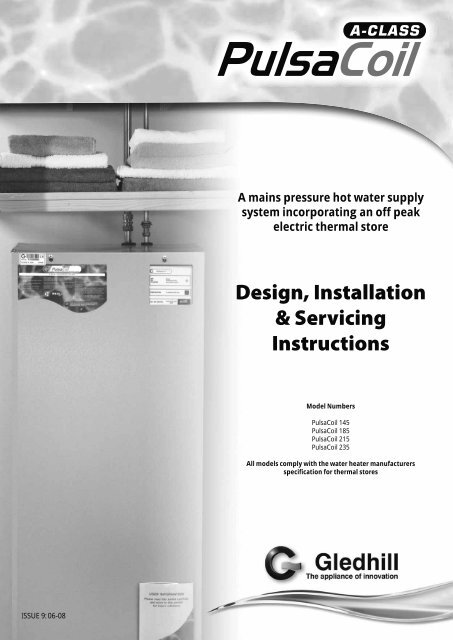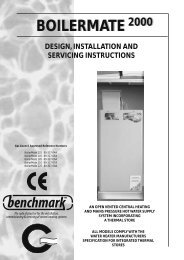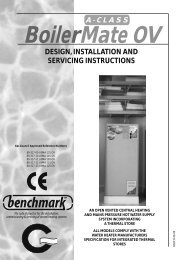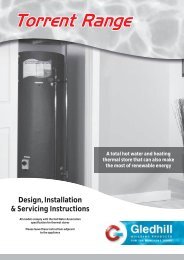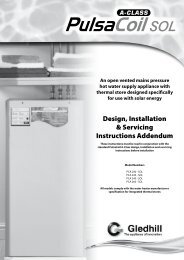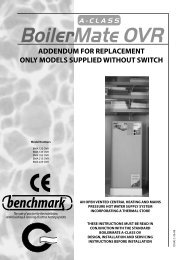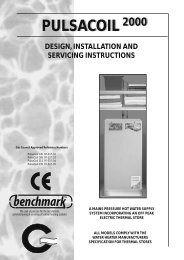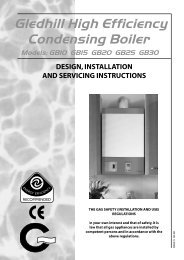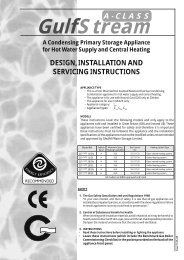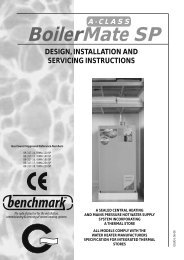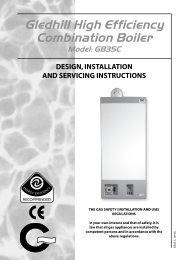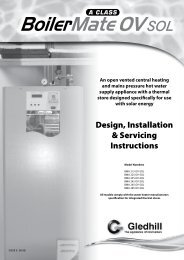PulsaCoil A-Class - Gledhill Spare Parts
PulsaCoil A-Class - Gledhill Spare Parts
PulsaCoil A-Class - Gledhill Spare Parts
You also want an ePaper? Increase the reach of your titles
YUMPU automatically turns print PDFs into web optimized ePapers that Google loves.
DESIGNAny water distribution system/installation must comply with the relevantrecommendations of the current version of the Regulations and British Standardslisted below:-Building RegulationsRequirements for Electrical InstallationsWater RegulationsManual Handling Operations RegulationsBritish StandardsBS6700 and BS7671.A suitably competent trades person must install the <strong>PulsaCoil</strong> and carry out anysubsequent maintenance/repairs. In fact the appliance front cover is secured by2 screws and this should only be removed by a competent trades person. Themanufacturer’s notes must not be taken as overriding statutory obligations.The <strong>PulsaCoil</strong> A-<strong>Class</strong> is not covered by section G3 of the current Building Regulationsand is therefore not notifiable to Building Control.The <strong>PulsaCoil</strong> A-<strong>Class</strong> is not intended for use by persons (including children) withreduced physical, sensory or mental capabilities, or lack of experience or knowledge,unless they have been given supervision or instruction concerning use of the applianceby a person responsible for their safety.Children should be supervised to ensure that they do not play with the appliance.The information in this manual is provided to assist generally in the selection ofequipment. The responsibility for the selection and specification of the equipmentmust however remain that of the customer and any Designers or Consultantsconcerned with the design and installation.Please Note: We do not therefore accept any responsibility for matters of design,selection or specification or for the effectiveness of an installation containing one ofour products unless we have been specifically requested to do so.All goods are sold subject to our Conditions of Sale, which are set out at the rear ofthis manual.In the interest of continuously improving the <strong>PulsaCoil</strong> range, <strong>Gledhill</strong> Water StorageLtd reserve the right to modify the product without notice, and in these circumstancesthis document, which is accurate at the time of printing, should be disregarded. It willhowever be updated as soon as possible after the change has occurred.INTRODUCTIONPage 3
DESIGN11Standard EquipmentThe standard configuration of the <strong>PulsaCoil</strong>A-<strong>Class</strong> is shown opposite. The Printed CircuitControl Board (A.C.B.), mounted inside theappliance, controls the operation of thecomplete system. This is pre-wired to a terminalstrip where all electrical connections terminate.It is supplied with the following factory fittedequipment:-31261516171. 3kW Off-Peak immersion heater2. 3kW On-Peak boost immersion heater3. Printed Circuit Board4. Plate heat exchanger5. Domestic hot water primary (plate heatexchanger) pump6. Isolating terminal connectors for dry fireprotection7. DHW temperature sensor8. Incoming cold water sensor9. Strainer and flow regulator10. Screwed connection for a drain tap11. Top up cistern complete with cold feed/open vent pipework assembly is suppliedseparately12. Overheat thermostat13. Middle store control sensor14. Bottom store control sensor15. Operation/warning light16. Boost/reset button17. On/Off switch1325Note : Both immersion heaters are low wattsdensity type with incaloy 825 sheaths and arespecially manufactured to suit Thermal Stores. Itis recommended that any replacements shouldbe obtained from <strong>Gledhill</strong> Water Storage.7Optional Extra Equipment4• Scale inhibitor for mains water services withhardness levels above 200 ppm (mg/l)• Hot and cold water manifolds for use withplastic pipework.TECHNICAL DATA1411089Figure 1.2• Ballvalve/overflow connector for top upcistern.Page 6
DESIGNAppliance Dimensions300 *350Top upcisternB*Min maintenanceaccess to comply withthe Water Regulations(ballvalve model only)ModelHeightAWidthBDepthCPCA145 1042 530 595PCA185 1142 530 595PCA215 1300 530 595PCA235 1440 550 595Note: The Appliance dimensions above do notallow for the100mm high installation base.The following table of minimum cupboarddimensions only allow the minimum spacerequired for the appliance (including the F & Ecistern). Any extra space required for shelvingetc in the case of airing cupboards etc mustbe added.DA<strong>PulsaCoil</strong> A-<strong>Class</strong>ModelMinimum Cupboard DimensionsHeightDWidthEDepthFPCA145 1800 550 600PCA185 1900 550 600PCA215 2050 550 600PCA235 2200 570 600100280ENote: The above dimensions are based on theAppliance and the Top up cistern (fitted with aballvalve) being in the same cupboard. If themanual fill method is chosen the heights canbe reduced by 125mm.If pipework needs to rise vertically adjacentto the appliance the width/depth will needincreasing to accommodate this.FTop upcistern420CThe minimumclear opening infront of theappliance to beat least thesame depth asthe appliance.MaintenanceaccessThe cupboard dooropening will needto take intoaccount the varioussizes of appliances.Figure 1.3TECHNICAL DATAPage 7
DESIGNPlan Of Appliance Connections595Connection Details/Dimensions For Top Of Unit53053120The <strong>PulsaCoil</strong> A-<strong>Class</strong> units are supplied onan installation base to allow the pipe runs toconnect to the appliance from any direction.It is easier if all pipes protrude vertically in thecut out area shown. Compression or push fitconnections can be used. All pipe positionsare approximate and subject to a tolerance of+/- 10mm in any direction. Space will also berequired for a 15mm cold water supply and a22mm warning / overflow pipe (if the optionalextra ball valve and overflow connector havebeen specified. If a warning/overflow pipeis NOT provided the F&E Cistern should befilled from a temporary hose connectionincorporating a double check valve. This canbe from a temporary hose connection suppliedfrom a cold water tap or a permanent coldbranch provided adjacent to the Top up Cistern.The temporary connection must be removedonce the appliance is filled.Note: All dimensions are shown in mm andare to the centre line of the pipework.323 - Open Vent385 - Cold Feed/ExpansionConnection Details/Dimensions For Bottom Of Unit530595TECHNICAL DATA550455 - Mains Cold Water Inlet490 - Hot Water OutletFigure 1.4Page 8
DESIGNHot and Cold Water SystemPipe Sizing / MaterialsTo achieve even distribution of the available supply of hot and cold water, it isimportant in any mains pressure system, that the piping in a dwelling should be sizedin accordance with BS 6700. This is particularly important in a large property withmore than one bathroom.However, the following rule of thumb guide lines should be adequate for most smallerproperty types as long as water pressures are within the recommended range.1. A 15mm copper or equivalent external service may be sufficient for a small 1bathroom dwelling (depending upon the flow rate available), but the minimumrecommended size for new dwellings is 22mm (25mm MDPE).2. The internal cold feed from the main incoming stop tap to the <strong>PulsaCoil</strong> A-<strong>Class</strong>should be run in 22mm pipe. The cold main and hot draw-off should also be runin 22mm as far as the branch to the bath tap.3. The final branches to the hand basins and sinks should be in 10mm and to thebaths and showers in 15mm (1 metre minimum).4. We would recommend that best results for a balanced system are achievedby fitting appropriate flow regulators to each hot and cold outlet. This isparticularly relevant where the water pressures are above the recommendedwater pressure range. Details of suitable flow regulators are provided inAppendix A.Note: If manifolds (available as an optional extra) are being used suitable flowregulators are automatically provided in the manifold and do not need to beprovided at each outlet. See Appendix B for further details.All the recommendations with regard to pipework systems in this manual are generallybased on the use of BS/EN Standard copper pipework and fittings.However, we are happy that plastic pipework systems can be used in place of copperinternally as long as the chosen system is recommended for use on domestic hotand cold water systems by the manufacturer and is installed fully in accordance withtheir recommendations.The hot water supply to a shower-mixingvalve should be fed wherever practical directlyfrom the <strong>PulsaCoil</strong> A-CLASS or be the first drawoffpoint on the hot circuit. The cold supplyto a shower-mixing valve should whereverpractical be fed directly from the rising mainsvia an independent branch. The shower mustincorporate or be fitted with the necessary checkvalves to provide back-syphonage protection inaccordance with the Water Regulations.The supply of hot and cold mains water directlyto a bidet is permitted provided that it is of theover-rim flushing type and that a type ‘A’ air gapis incorporated.Hot and Cold Water SystemIf the length of the hot water draw off pipeworkis excessive and the delivery time will be morethan 60 seconds before hot water is availableat the tap, you may wish to consider using traceheating to the hot water pipework such as theRaychem HWAT system. Please consult <strong>Gledhill</strong>Technical Department for further details.Note: A conventional pumped secondarycirculation system is NOT suitable for use withthis appliance.It is important that the cold water pipeworkis adequately separated/protected from anyheating/hot water pipework to ensure thatthe water remains cold and of drinking waterquality.This is particularly important in relation to use of push fit connections when using theoptional flexible hose kits - see installation section of this manual.It is also essential that if an alternative pipework material/system is chosen themanufacturer confirms that the design criteria of the new system is at least equivalentto the use of BS/EN Standard copper pipework and fittings.Taps/Shower FittingsAerated taps are recommended to prevent splashing.TECHNICAL DATAAny type of shower mixing valve can be used as long as both the hot and coldsupplies are mains fed. However all mains pressure systems are subject todynamic changes particularly when other hot and cold taps/showers are openedand closed, which will cause changes in the water temperature at mixed wateroutlets such as showers. For this reason and because these are now no moreexpensive than a manual shower we strongly recommend the use of thermostaticshowers with this appliance.The shower head provided must also be suitable for mains pressure supplies.However, if it is proposed to use a ‘whole body’ or similar shower with a number ofhigh flow/pressure outlets please discuss with the <strong>Gledhill</strong> technical department.Page 10
1INSTALLATION1 2 340 1RELAY R2200 - 240Vac 50Hz2 4 6 8S1 & S2S3S4S5S6YGBrWhBrWhBrWhBrWhBrWh0 1RELAY R1200 - 240Vac 50Hz2 4 6 8BlBrCOM11NLONIHLONPEAKLONPEAKNONPEAKPEONIHNOFFIHLOFFPEAKLOFFPEAKNOFFPEAKPEL N E L N EOFFIHNONPEAKF1OFFPEAKF214RELAYR312PART No.XB142SPD1/2A2 3 4ONA2A1SCALE INHIBITORINSTALLATIONOn Peak Supply1.5mm FlexON PEAK2 2DRN. DATECH'KD. SIGN. DATE. APP'D. SIGN.DATES. McGachie 08-06-07 S. McGachie08-06-07 S. Gataora08-06-07DATE : JUNE 2007APPROVEDOff Peak Supply1.5mm FlexOFF PEAKISSUE No : 6DO NOT SCALE FROM THIS DRAWING. COPYRIGHT OF THIS DRAWINGIS RESERVED. IT IS NOT TO BE REPRODUCED COPIED OR DISCLOSEDTO A THIRD PARTY EITHER WHOLLY OR IN PART WITHOUT OURWRITTEN CONSENT.© GLEDHILL WATER STORAGE LTD.Page 14
INSTALLATION5678RBlRBlYYBBOrOrOrOrBrBrBBRBlRBlYYJ9RRID_RESISTORJ31ROrBrBFRONT PANELROrRed LEDBrBPush ButtonOff - On Green Neon Rocker1BABrBr0 1B1A1J30CJ29J3Br(ON PEAK IMMERSION HEATER)(ON PEAK SIGNAL)VR(OFF PEAK IMMERSIONHEATER)J33(OFF PEAK SIGNAL)VJ28J32G/YJ34BlBBrG/YJ5BlBrL N EMDHWPumpDOn PeakImmersionOff PeakImmersionE3kWTOPGLEDHILL WATER STORAGE LTD.SYCAMORE TRADING ESTATESQUIRES GATE LANEBLACKPOOLLANCASHIREFY4 3RLTITLE3kWBOTTOM'A' CLASS PULSACOIL APPLIANCEELECTRICAL SCHEMATIC DRAWING* All wire sizes 0.5mm² unless otherwise statedJOB NAME'A' CLASS PULSACOIL APPLIANCEDRG. SIZE DRG. NAMEA3 'A' <strong>Class</strong> Pulsacoil ver 6.aiINSTALLATIONPage 15
INSTALLATIONPreparation/placing The Appliance InPosition.The ‘first fix’ pipework positions should bechecked using the template provided witheach appliance. If these have been followedinstallation is very simple and much quickerthan any other system.The appliance is supplied shrink wrapped on atimber installation base. Carrying handles arealso provided in the back of the casing.The feed and expansion cistern complete withballvalve, cold feed/expansion and overflow/warning pipe fittings are provided in a separatebox.The appliance should be handled carefully toavoid damage and the recommended methodis shown above.HANDLINGWhen lifting the unit work with someone of similar build and height if possible.Choose one person to call the signals.Lift from the hips at the same time, then raise the unit to the desired level.Move smoothly in unison.Larger units may require a team lift.A specific manual handling assessment is shown in Appendix Dat the rear of this manual.Note: Although the above guidance is providedany manual handling/lifting operations willneed to comply with the requirements of theManual Handling Operations Regulations issuedby the H.S.E.The appliance can be moved using a sack truckon the rear face although care should be takenand the route should be even.In apartment buildings containing a numberof storeys we would recommend that theappliances are moved vertically in a mechanicallift.If it is proposed to use a crane expert adviceshould be obtained regarding the need forslings, lifting beams etc.Before installation the site requirements shouldbe checked and confirmed as acceptable.The plastic cover and protective wrappingshould be removed from the appliance and theinstallation base (provided) placed in position.The appliance can then be lifted into position inthe cupboard on top of the base and the frontpanel removed by unscrewing the 2 screws andlifting the door up and out, ready for connectionof the pipework and electrical supplies.INSTALLATIONThe feed and expansion cistern support shallbe installed ensuring that the base is fullysupported, the working head of the applianceis not exceeded and the recommended accessis provided for maintenance - see the TechnicalData section of this manual for details.Page 16
INSTALLATIONPipework ConnectionsThe position of the pipework connections isshown opposite. The exact location dimensionsare listed in the Technical Data section of thismanual.All the connections are also labelled on theappliance. It is essential that the pipework isconnected to the correct connection.Connections A and B are plain ended copperpipe.Connection C and D compression fittings.Connection E is RC½ (½ in BSPT internal)ABA -B -C -D -E -22mm Safety open vent15mm Cold feed/expansion22mm Incoming mains cold water22mm Domestic hot water½” Drain tap connectionNote: The safety open vent and cold feed/expansion must be connected to the top upcistern using the pipework assembly provided.Do not alter or connect any pressure-reliefdevice to the vent pipe of this water heater.All factory made joints should be checked afterinstallation in case they have been loosenedduring transit.The fittings for the top up cistern should beinstalled following the instructions providedand the cistern fitted on its supports/top ofthe appliance.The cold feed/expansion and safety open ventshould be installed between the appliance andthe top up cistern.DECFigure 1.6INSTALLATIONPage 17
INSTALLATIONCombined Feed And Open Vent PipeIt is normally envisaged that the top up cistern will be located in the same cupboardas the <strong>PulsaCoil</strong> A-<strong>Class</strong> appliance itself to maintain a dry roof space.The cold feed/open vent pipework assembly (as supplied) should be used to installthe top up cistern directly on top of the appliance.If it is necessary to locate the cistern in the roof space (or on a higher floor) the coldfeed/open vent pipework assembly (as supplied) should be used to connect to the topup cistern and pipework site run by the installler to connect this to the appliance.Obviously, any pipework in the roof space and the feed and expansion cistern willneed to be adequately insulated to protect against frost damage.Combined Feed And Open Pipe Arrangements Must Not Be Used.No valves should be fitted in the safety open vent which must be a minimum of 22mmcopper pipe or equivalent throughout its length.The mains cold water supply to the ballvalve (if provided) shall be provided with asuitable servicing valve.The overflow/warning pipe (if provided) shall have a continuous fall, be fitted todischarge clear of the building and be sited so that any overflow can be easily observed.It shall also be installed in a size and material suitable for use with heating feed andexpansion cisterns in accordance with BS 5449 (e.g 22mm copper) and should nothave any other connections to it.Electrical Connection - Standard ApplianceThe <strong>PulsaCoil</strong> A-<strong>Class</strong> is pre-wired internally,strictly in accordance with the IEE Requirementsfor Electrical Installations BS 7671. The externalwiring/connections should be carried out by acompetent person to the same standard. Thearrangement of the internal wiring is shown onthe previous page.All the terminals are suitably labelled.Note: Do not attempt the electrical work unlessyou are competent to carry it out to the abovestandards.Before commencing check that the powersource is in accordance with the SiteRequirements section of this manual andensure that it is isolated as shown in the SystemDetails section.Run the external wiring from the adjacentisolator through the service slot provided in thebase of the appliance.Make the connections as shown below.Note: If a warning/overflow pipe is NOT provided the top up cistern should befilled from a temporary hose connection supplied from any cold water tap orfrom a permanent cold branch provided adjacent to the top up cistern. Thetemporary hose must be fitted with a double check valve and removed oncethe appliance is filled.ONIHLON ON ONPEAK PEAK PEAKL N PEONIHNOFFIHLOFF OFF OFF OFFPEAK PEAK PEAK IHL N PE NThe store may fill more slowly than the feed tank. It is important to check thewater level again in the cistern after commissioning.L N E L N ECold feed / open ventpipework(as supplied)On Peak Supply21.5mm FlexON PEAKClamp the cables in the grips provided andensure all cables are routed to avoid hotsurfaces.OFF PEAKOff Peak Supply21.5mm Flex<strong>PulsaCoil</strong>InterconnectingPipework(By Installer)Note: The appliance pipework should be bondedto earth to comply with the IEE Requirementsfor Electrical Installations BS 7671.Before switching on the electrical supply checkall the factory made terminal connections toensure they have not become loose duringtransit.INSTALLATIONFigure 1.7Page 18
INSTALLATIONOpen the incoming stop valve and fill the domestic mains cold and hot water systemsincluding the <strong>PulsaCoil</strong> A-<strong>Class</strong> appliance.Check the water level in the top up cistern and if a ballvalve is fitted adjust ifnecessary.Check the whole of the domestic hot and cold distribution systems for leaks. Fullyflush and if necessary chlorinate the hot and cold water system in accordance withthe recommendations in the Water Regulations and BS 6700.Please note that the whole of the domestic hot and cold water systems including theappliance must be adequately flushed after chlorination. Failure to do this can causedamage to the plate heat exchanger/immersion heaters etc. If there are any doubtsregarding this or the quality of the water being used to fill the <strong>PulsaCoil</strong> appliance aninhibitor such as Fernox MBI or Sentinel X100 should be added to the appliance whenfilling in line with the manufacturers instruction for these products.Check that the top up tank is filled up to the water level shown on the label. If it is amanual fill model, this is most important.If a ballvalve is provided, turn down the servicing valve once the system is finallyfilled to the point where the warning/overflow pipe will cope with the dischargearising from a ballvalve failure.If an overflow is not provided ensure the temporary filling hose is isolated andremoved from its connection to the cold water supply.It is essential that all systems function properly for optimum performance.To achieve this the flow rate from each tap should be checked and a suitable numberof taps run simultaneously to check the impact of this on the flow rate at individualtaps.Put the on/off switch on the front control panelto the on position to activate the appliancecontrol board. The switch will glow green whenin the on position.If an off peak supply is not available the onpeakboost immersion heater will need to beswitched on by pressing the black button. Thered light will change to permanently on.It can be checked that the boost immersionheater is drawing current by use of a clampmeter on the live supply when boost is activeor by interrogating the printed circuit controlboard in accordance with the instructions in thefault finding section of this manual.The sensor control set points are shown onpage 25 and can be checked on the 2 digit ACBdisplay.The boost immersion heater can be switchedoff by pressing again the black button.If an off peak supply is available at the timethe appliance is switched on the appliance willautomatically switch on the off peak immersionheater. Its operation can be checked in thesame way as described above for the on peakimmersion heater. When the off peak supplyis available the on peak immersion heateroperation can still be checked as describedabove by switching off the off peak supply.OFFONFLASHINGPUSH BUTTONON/OFF SWITCHNormalOn-Peak boost activeFault attention requiredTo activate On-Peak boostControl circuit powersupplyNote: If the on and off peak supplies have beenconnected wrongly (“crossed”) at the applianceit will not operate properly (it may charge if offpeak is available but will not carry out any otheroperations)If the appliances has been connected with thepolarity incorrect it will not operate at all.See the fault finding section of the manual forfurther details.We recommend that flow regulators are provided for each tap/terminal fittingto ensure that the available flow is shared evenly - See Appendix A for furtherdetails.Commissioning the <strong>PulsaCoil</strong> Control SystemOnce the <strong>PulsaCoil</strong> A-<strong>Class</strong> is filled with water, check the on/off switch on the front isin the off position. The electrical supplies can then be switched on and the switcheson the two isolating terminal connectors can be pushed home.WARNING - Pushing home these switches will complete the electrical circuit to theimmersion heaters. DO NOT PUSH HOME THESE SWITCHES AND SWITCH ON THEELECTRICITY SUPPLY UNTIL YOU HAVE CHECKED THAT THERE IS WATER IN THE F& E CISTERN. Failure to do this can result in dry firing and premature failure of theimmersion heaters, which will invalidate the warranty.Run a tap and using a digital thermometercheck that the temperature of the hot water isabout 52°C. This temperature is factory set and isindependent of the store temperature assumingthe store is above 55°C and typical hot waterflow rates of 6-25l/min are being drawn.This product is covered by the ‘Benchmark’scheme and a separate commissioning/service log book is included with thisproduct. This must be completed duringcommissioning and left with the productto meet the Warranty conditions offered by<strong>Gledhill</strong>.COMMISSIONINGPage 19
SERVICINGImportant Do’s and Don’ts1. DO check the incoming mains water pressure. The preferred range of mainspressure is 2 -3 bar.2. DO check the flow rate of the incoming cold water main is adequate to meet themaximum hot and cold water simultaneous demands.3. DO check that all connections are in accordance with the labelling on the thermalstore.4. DO NOT push home the 2 switches on the isolating terminal connectors andswitch on the electricity supply until you have checked that the appliance is fullof water i.e. there is water in the top up cistern.5. DO check the water level is correctly set in the top up cistern when cold and iffitted that there is no overflow when the appliance is up to temperature.6. DO check that the sensors switch the immersion heaters off at the correct setpoint i.e. approx 70°C.7. DO insulate any exposed hot water pipework in the <strong>PulsaCoil</strong> cupboard.8. If the ballvalve in the F & E cistern is permanently connected to the mains coldwater supply DO plumb the overflow/warning pipe in a 20mm internal diameterpipe and ensure it discharges in a conspicuous external position. Use a materialwhich is suitable for use with heating F & E cisterns in accordance with BS 5449(such as copper).9. DO ensure the green light ‘on/off’ switch glows.10. Once the appliance is filled and commissioned DO leave the electricity switchedon to the appliance to ensure the automatic pump run facility can operate toprevent the pump sticking.11. DO ensure that the functioning and control of the system is explained to theoccupant.12. DON’T place any clothing or other combustible materials against or on top of thisappliance.These instructions should be placed along with the component manufacturersinstructions in the pocket provided on the rear of the front panel. The frontpanel should then be refitted.Annual ServicingNo annual servicing of the <strong>PulsaCoil</strong> A-<strong>Class</strong> isnecessary.However, if required, the operation of thecontrols and a hot water performance test canbe carried out to prove the appliance is workingsatisfactorily and within its specification.If it is decided to carry out the above tests thewater level in the top cistern should also bechecked and if necessary topped up.Changing ComponentsFree of charge replacements for any faultycomponents are available from <strong>Gledhill</strong> duringthe in-warranty period on return of the faultypart (normally 12 months).After this, spares can be obtained direct from<strong>Gledhill</strong> using the ‘Speed <strong>Spare</strong>s’ service, orthrough any of the larger plumbers merchants/specialist heating spares suppliers.Help and advice is also available from theTechnical Helpline on 08449 310000.However, all components are readily accessibleand can be changed quickly and easily by theinstaller using common plumbing/electricalpractice.Note: All maintenance work on the <strong>PulsaCoil</strong>appliance must be carried out by a competenttrades person.ANNUAL SERVICE/CHANGING COMPONENTSNote:The pump is a Grundfos UPR 15-50 4 wirepattern and any replacement must be thesame model.Page 20
SERVICINGDescription Supplier & Model Part Number Stock Code1 PHE pump Grundfos, UPR 15-50 5950543 GT0892 Plate heat exchanger (PHE) SWEP, 24 Plate heat exchanger E8T/24 GT0173 Pump isolating valve - outlet Watt Industries, 90° valve 7308123 GT1354 Pump isolating valve - inlet Watt Industries GT1335 Top immersion heaterShell, 14” Immersion heater - no stat Incalloy 825 XB0836 Bottom immersion heater7 Main PCB controller Argus Vision 147/4GS controller 147/4GS GT4908 Middle sensor Tasseron, Single sensor TSK10B4 GT1989 Top (OHT) sensor Tasseron, Duplex sensor TSK11B4 GT19910 Front panel display RH Technical, Membrane overlay P210328 XB41111 Front panel display harness RH Technical, Membrane harness XB05712 Off-Peak circuit fuse holder Phoenix, (Part of DIN rail assembly-non stock item)13 Control & off-peak circuit fuses RS Components, 5A FF 415-626 XB38214 Off-Peak/On-Peak contactor Duracool XB17815 Bracket Duracool XB179Phoenix, Bespoke terminal and component16 Complete DIN rail assemblyXB180assembly17 Complete wiring harness18 On-Off switch (part of panel) Arcoelectric, Green illuminated rocker switch C5503-ALNAK CA00619 DHW inlet & outlet sensors Tasseron, single sensor complete with nut & oliveWet pocketsensor, comesas a kit.GT198+GT29520 Relay RelpolRM87N-2311-35-5230XB42421 DIN rail socket Relpol GZT92 XB42512 3 4 5/6 78/199 10 11 12 1314/15 16 17 18 20 21SHORT PARTS LISTPage 21
SERVICINGThe <strong>PulsaCoil</strong> A-<strong>Class</strong> appliance control panel and printed circuit control board/displayhave been designed to be fully automatic whilst able to provide functional anddiagnostic information to the householder/installer.The panel/board work in conjunction with a number of sensors (thermistors) locatedas shown in the diagram below.Automatic Control OperationHeating of the store is controlled by sensors S1/S2 and S5 and S6. The control setpoints are shown in the table on page 25.During normal charging cycle sensor S5 will control the bottom off peak I.H. in thesame way S6 will control the top on peak I.H. when manually activated.In the event of either of these sensors failing, control will be taken over by sensorsS1/S2.Normally, sensors S1/S2 are used to detect an overheat condition (over 95ºC) whichwill cause the red LED on the front control panel to flash (rapid).S1/S2S6On/P HeaterS5Off/P HeaterS4S3This condition should not normally be reached as sensors S1/S2 will also switch offthe supplies to the I.H’s if a temperature above 85ºC is detected. Normal operation willautomatically resume when the temperature at the sensors drops below 78ºC.The hot water temperature is controlled by sensors S3 and S4.S3 checks for a drop in temperature every second and if the drop is more than 2ºC,it switches on the hot water pump to raise the domestic hot water temperature to52ºC (± 2°C).SensorsS1/S2 Store/OH sensorsS3 DHW inlet sensorS4 DHW outlet sensorS5 Control sensor for Off peak HtrS6 Control sensor for On peak HtrFAULT FINDINGThe control of the hot water temperature is carried out by sensor S4 adjusting thespeed of the hot water pump.The pump is stopped once S3 reaches a temperature of above 30°C.The following checks should be carried out by the installer before calling themanufacturer.Noise When Hot Water Tap Is Opened/closedIf the plate heat exchanger pump is noisy when the hot water tap is opened, thencheck the level of water in the F & E cistern and vent the pump if necessary.Water hammer - loose pipework and/or tap washers and/or washing machinevalves.Causes of ‘Unsatisfactory Hot Water Service’See table opposite.Overflow from Feed and Expansion CisternCheck that the controlled level of water in the cistern is at the correct level. Adjust ifrequired and check the ballvalve is shutting off the water supply.Fault ConditionDHW temperatureremains coldexiting the taps.DHW temperaturefluctuates wildlywhen flow issteadyDHW temperatureexceeds andremains well above60°C when theflow rate is low.Store not heatingPossible Causes- Thermal store is cold/DHWpump is permanently stuck- Temperature sensor orprinted circuit controlboard is faulty.- The water level is low in theF&E Cistern- Overheat stat tripped- One or both immersionheaters have failed- DHW pump keeps stickingintermittently- Hot & cold crossed atappliance.- DHW printed circuit controlboard and/or temperaturesensor is/are faulty.- Immersion heaterthermostat temperaturesetting too high shouldbe 70°C.- The two switches onthe isolating terminalconnectors are not pushedhome - i.e. unit is notcommissioned.- No power supplies/fusesare blown.- Overheat stat has tripped.- One or both immersionheaters have failed.Page 22
SERVICINGNormal - standby stateIndicate system statusPress S2Sensor temperaturereadingPressS1PressS1S2 S1PressS1PressS1S2 S12 digitdisplay2 pushbuttonsMainprocessorPress S2Control set-pointreadingPressS1PressS1PressS1PressS1Press S2Fault code indicatorlock outsPressS1PressS1PressS1PressS1Press S2Fault code indicatorblock outsPressS1PressS1PressS1PressS1Fuse T3.15L 250V2 DIGIT ACB BOARD DISPLAY FLOW CHARTAPPLIANCE CONTROL BOARD (A.C.B)Appliance Control BoardThe appliance control board (shown opposite) has a 2 digit display and 2 push buttonswhich are used to check the status of the appliance, check and set its identity andinterrogate it for the current faults and the fault history.The 2 digit display is controlled by 2 buttons S1 and S2. The flow chart of display modesis shown above. Generally, each press of button S2 cycles the display from top tobottom and each press of button S1 cycles the display functions from left to right.The button S2 is also used to reset the appliance i.e. clear the lockout errors and resetthe appliance. (Note: Appliance resetting can also be carried out using the pushbutton on the front panel)Note: The board is used on a range of products and not all terminals are used onevery appliance.Display in Normal (Standby) ModeIn the standard/normal mode the 2 digit display indicates the status of the applianceinputs and outputs by switching on the appropriate segments of the display - seepage 24 for details.Appliance Type SelectionThe <strong>PulsaCoil</strong> is fitted with an identity (ID) resistor which is read by the controller forcomparison with the appliance type (code) set on the controller. The two must matchfor the controller/appliance to function. Therefore if either the appliance code settingor the ID resistor is wrong, the appliance will shut down safely and flag the error codeuntil the fault is rectified. The controller codes and the ID resistor values for the <strong>PulsaCoil</strong>are 03 and 3K3 respectively. The procedure forchecking and setting the appliance code on thecontroller is described below.• The appliance selection menu (A0 ... A9) onthe controller is hidden. It is only possible toget to the appliance selection using the resetbutton (Left hand, S2) on the main board.• When going from the show ‘ locking error’ toshow ‘blocking error’ menu (see opposite),do not release the button but hold it for 10seconds. The display will change from ‘c’ to‘A’. At this stage the push button (S2) can bereleased.• The appliance type can now be selected byusing right hand push button, S1, e.g. for thisappliance A03.Press the reset button, S2, to accept thesetting.If the selected appliance code does not matchwith the ID resistor fitted to the appliance, then,an error ‘33’ will be displayed.FAULT FINDINGPage 23
SERVICINGControl panel - (on thefront of the appliance)This is designed for operation by the householderand the operation is in line with the instructionson the panel.OFFONFLASHINGNormalOn-Peak boost activeFault attention requiredRed LED indicatorPUSH BUTTONON/OFF SWITCHTo activate On-Peak boostControl circuit powersupplyBlack push buttonGreen rocker switch -illuminated when in the‘ON’ positionS6 sensor (top)callingOff peak supplypresentDHW pump onIf a sensor error is detected one of the followingthree error codes flash alternately with thesensor number instead of the temperatureOn peak supplypresentS5 sensor(bottom) callingOn peak heateronOff peak heateronE1 Open circuitE2 Short circuitE3 Temperature greater than 99°CA code of FF indicates the fault location isempty.If flashing on its own, the systemis running normalIf flashing on its own system haslocked out and needs a resetIf both flashing indicates a fault but unit is still workingFAULT FINDINGSensor Control Set PointsS1 Top immersion heater sensor on (S6) 70°CS2 Top immersion heater sensor off (S6) 78°CS3 DHW in (S6) 35°CS4 DHW out (S6) 52°CS5 Bottom immersion heater sensor on (S6) 75°CS6 Bottom immersion heater sensor off (S6) 79°CSensor Control Set PointsCodeCode10 Overheat error 45 S1 overheat 1 shorted30 Phase error 48 I.D. resistor shorted33 Appliance selection 49 S4 sensor shorted37 S1 overheat 1 open 50 S5 sensor shorted40 I.D. resistor open 51 S6 sensor shorted41 S4 sensor open 52 S2 overheat 2 shorted42 S5 sensor open 55 Top IM failure43 S6 sensor open 56 Bottom IM failure44 S2 overheat 2 openAny other code displayed should be checked against the full chart.The set point reading mode is normally onlyused by the <strong>Gledhill</strong> engineer to check thesensor set points are still correct. The set pointalternately flashes with S1-S6.See table opposite for set points.Note: The S1-S6 reference display does notcorrespond with the S1-S6 sensor referencesused earlier. These are shown in brackets onthe table opposite.The two fault code indication modes are againmainly for use by the <strong>Gledhill</strong> engineer and canonly be used with a reference table.The Blocking errors will clear automaticallywhen the fault is cleared/component changed.The Locking errors can only be cleared byresetting the controller.In each case there are 16 fault locations storedin date order with C0 being the latest and CFthe first.The most common fault codes are shownopposite. Not all appliances use all the errorcodes available.For further assistance please call the <strong>Gledhill</strong>Technical Helpline on 08449 310000.Page 24
APPENDIXWater SavingsWater Related Costs Can Be Reduced By Good Plumbing Practice11212 taphalf openUnregulatedOver20 l/mFitted with regulator5, 6 or8 l/m22TAPS & MIXERSUnregulated25 - 30 l/mRegulated10 - 12 l/mSHOWERS4 Fixing Options For Taps & Mixers1. MK Range - Combined Regulators & Aeratorfor screwing onto Taps & Mixers with internalor external threads on their noses. Anti Vandalmodels also available.2. MR05-T Range - Internal Regulators. Pushfitinto Tap or Mixer seats. Produced inthree sizes - 12.5mm (BS1010), 12mm &10mm, Flangeless models also available forTaps with Low Lift washers.3. MXF Standard Range - Screw on tailmodels for Taps & Mixers. Fix onto the tailsbefore fitting the tap connectors. Availablein 3/8", 1/2", 3/4" and 1" BSP.Vast quantities of water are needlessly run off to waste due to Taps, Mixers and Showersdischarging flow rates far in excess of the rates required for them to perform theirduties.The contrasting flow rates shown on this leaflet clearly illustrate the savings that canbe made whilst still providing a good performance.British made Aquaflow Regulators provide constant flow rates by automaticallycompensating for supply pressure changes between 1 bar & 10 bars.4. Compression Fitting Range - “In Line”regulators housed in 15mm & 22mm CXCCouplers & Isolating Valves. “ ”UK WFBS listedby the Water Research Centre. Isolation valvesavailable for slotted screwdriver operation orwith coloured plastic handles. Now availablealso in plastic bodied push-fit couplers &valves.To facilitate installation into the wide range of plumbing equipment which isencountered in the U.K, Four Fixing Options are available:-Options For Showers331. MXF “DW” Range - For fitting behind Fixed Shower Heads or onto Flexible Hoses forHandshowers (preferably onto the inlet end when lightweight hoses are used).12. Compression Fitting Range. “In Line” regulators as in Option 4 for Taps & Mixers.Information by courtesy ofAQUAFLOW REGULATORS LTDHaywood House, 40 New Road, Stourbridge, West Midlands DY8 1PATELEPHONE (01384) 442611 FAX: (01384) 4426124APPENDIX APage 25
APPENDIXManifoldsManifold type: 1 - Stock Code MIP 050(one bathroom, one en suite shower room, one cloakroom, one kitchen)Flow regulator(litres/minutes)Terminal fittingHot watermanifold outletsQuantityCold watermanifold outletsQuantity18 Bath tap 1 19 Hand basin 3 312 Kitchen sink 1 19 Toilet cistern None 39 Shower 1 112 Washing machine 1 19 Dishwasher None 1Total 7 11Two sets of manifolds are available as anoptional extra. Each set comprises a separatehot and cold water manifold. Both are providedwith a 22mm inlet connection located centrally.All outlet connections are 15mm compression.The centre to centre dimension of each branchis 55mm.595mm595mm2 No 6mmfixing holesblank18 l/mm12 l/mm9 l/mminlet9 l/mm9 l/mm9 l/mm12 l/mmblank18 l/mm12 l/mm9 l/mm9 l/mminlet9 l/mm9 l/mm9 l/mm9 l/mm12 l/mm55mmA (hot)9 l/mm9 l/mm165mmB (cold)Manifold type: 2- Stock Code MIP 060(two bathrooms, one en suite shower room, one cloakroom, one kitchen,one utility room)Flow regulator(litres/minutes)Terminal fittingHot watermanifold outletsQuantityCold watermanifold outletsQuantity18 Bath tap 2 29 Hand basin 4 412 Kitchen sink 2 29 Toilet cistern None 49 Shower 1 112 Washing machine 1 19 Dishwasher None 1Total 10 15The arrangement of each manifold is supplied asshown. This provides the best balance of flowsbut the flow regulators/duty of each branch canbe changed if required as long as a reasonablebalance is maintained. If it is necessary tochange or clean the flow regulator this can bedone without needing to drain the system byclosing the valve and removing the screwedcover below the white plastic cover.The manifolds are designed to be used withplastic pipework and are supplied completewith isolation valves and flow regulators oneach branch. They would normally be installedin the same cupboard as the thermal storageappliance (as shown below) but can be installedin another cupboard close to the appliance ifrequired.595mm595mm85mmAPPENDIX B18 l/min12 l/minC12 l/min9 l/min(hot)inlet9 l/min9 l/min9 l/min9 l/min12 l/min18 l/min18 l/min9 l/mm12 l/min9 l/mm12 l/min9 l/mm9 l/mininlet9 l/min9 l/min9 l/min12 l/min18 l/min9 l/mm9 l/mm9 l/mm55mmD(cold)85mm90mm90mm195 mmPage 26
APPENDIXThe preferred solution wherespace will allowAn optional location wherecupboard space is tightThe pressure loss through a flow regulator at thedesignated flow rate is about 1.8 bar. Thereforefor the flow regulator to control the flow rate atpre-set level, the inlet pressure must be greaterthan 1.8 bar. If the inlet pressure is lower, theflow rate will be correspondingly less than thepre-set values.The maximum equivalent pipe lengths fromthe manifold to the terminal fittings can beestimated from the above information andthe resistance characteristics of the pipes.The examples presented below are for 15mmcopper pipe in table 1 and for plastic pipeworkin table 2.The size of the distribution pipes supplyingthe manifold should be calculated usingthe method set out in BS 6700. A typicaldiagrammatic arrangement of a system usingManifold Type 1 is shown below.Table 1: Maximum equivalent pipe length in 15mm copperInlet pressureMaximum equivalent length of pipe (m)(bar)@ 9 l/m @ 12 l/m @ 18 l/m2.0 25 10 52.5 75 30 153.0 150 60 30Table 2: Maximum equivalent pipe length in plastic pipeInlet pressureMaximum equivalent length of pipe (m)(bar)@ 9 l/m @ 12 l/m @ 18 l/m2.0 1.5 15mm : 10 15mm : 4.522mm : 402.5 3.0 15mm : 20 15mm : 9.022mm : 80.03.0 4.5 15mm : 30 15mm 13.522mm : 120This is only meant to show the principlesinvolved and the actual connection of fittings tothe manifold will need to suit the arrangementsshown on page 42.Note: If it is proposed to fit chemical watertreatment such as a water softener this shouldbe fitted in this location and the cold waterbranch in the sink should be branched off thecold water main prior to the treatment deviceinstead of the cold water manifold.Any other isolating/control valves and backflowprotection devices should be provided asnecessary to comply with the WaterRegulations.Pressure limiting valve NOT REQUIREDat pressures below 5 bar unless anysystem components have a lowermaximum working pressureMainssupplySee Note 1DWWMKitchen sinkScaleinhibitorNOT REQUIREDAiringcupboardThermalStoreEn-SuiteDouble check Kitchenvalve NOT REQUIREDunless supply pipeservices more thanone dwellingCheck valveNOT REQUIREDunless chemicalwater treatmentis fittedBath Toilet Handcistern basinBathroomToiletcisternHandbasinCloak roomShowerToiletcisternHandbasinAPPENDIX BPage 27
APPENDIXAPPENDIX CPage 28
APPENDIXMANUAL HANDLING OF APPLIANCE PRODUCTSDescriptionManual handling means any transporting or supporting of a load (including lifting,putting down, pushing, pulling, carrying or moving) by hand or bodily force.ScopeThis assessment will cover the largest Appliance, namely ElectraMate, GulfStream,BoilerMate, SysteMate, <strong>PulsaCoil</strong>, Accolade and Stainless Lite manufactured by<strong>Gledhill</strong>.The maximum weight of the largest product in each range is 98kg and the size is595 x 595 x 2020 mm high.Main HazardsVision may not be clear due to the size of the products.Adopting an incorrect method of lifting may cause injury, attempting to lift theseproducts will require help from others. (Team lifts)Control MeasuresManual lifting procedureThe lift, key factors in safe lifting are:a. Balanceb. Position of backc. Positioning of the arms and bodyd. The holde. Taking the lead for team liftsa. Balance - Since balance depends essentially upon the position of the feet,they should be apart about hip breadth with one foot advanced giving fullbalance sideways and forward without tension. In taking up this position,lifting is done by bending at the knees instead of the hips and the musclesthat are brought into use are those of the thigh and not the back.b. Position of back - Straight - not necessary vertical. The spine must bekept rigid, this coupled with a bent knee position, allows the centre line ofgravity of the body to be over the weight so reducing strain.c. Positioning of arms and body - The further arms are away from the side,the greater the strain on the shoulders, chest and back. Keep elbows closeto the body arms should be straight.d. The hold - Before lifting ensure you have a good hold. Two handles areprovided on Appliance products at the top rear side, these allow one ortwo persons to have a purposely-designed hold at the top of the applianceto ensure easy lifting at the top of the product. Each appliance is suppliedwith a pallet, which has been attached to the unit via the packaging. Thepallet will also allow for one or two persons to get a good hold.e. Taking the lead for team lifts- Asmore than one person is requiredfor these products ensure that oneperson is taking the lead. This maybe you so ensure that each personthat is helping is made aware of theweight and of the items listed withinthis assessment. Make sure you andany others helping know the routeyou intend to take that it is clear ofany obstructions. Never jerk the loadas this will add a little extra force andcan cause severe strain to the arms,back and shoulders. If there are stepsinvolved decide on where you willstop and take a rest period. Movesmoothly and in unison taking care tolook and listen to others helping withthe lift. Where possible use a sacktruck to move the product over longflat distances, only lift the productswhen necessary. If in doubt stop andget more help. The unit handles andpackaging with the pallet have beendesigned to ensure that two-fourpeople can assist when lifting upstairs or over longer distance.Individual capabilityIndividual capability plays an importantpart in handling these products. Personsabove average build and strength willfind it easier and should be in goodhealth. Persons below average build andstrength may require more rest periodsduring the handling process.Pregnant women should not carry outthis operation.Persons who are not in good healthshould seek medical advice prior tocommencing any lifting or manualhandling operation.Residual riskFollowing the guidelines given above willreduce any risk to injury.All persons carrying out this operationmust be fully trained and copies of thespecific risk assessment made availablefor inspection and use in their trainingprocess.Further guidance on Manual Handlingcan be obtained from the Health andSafety Executive. Manual HandlingOperations Regulations 1992.APPENDIX DPage 29
TERMS AND CONDITIONSPage 30
Page 31TERMS AND CONDITIONS
The code of practice for the installation,commissioning & servicing of central heating systems


